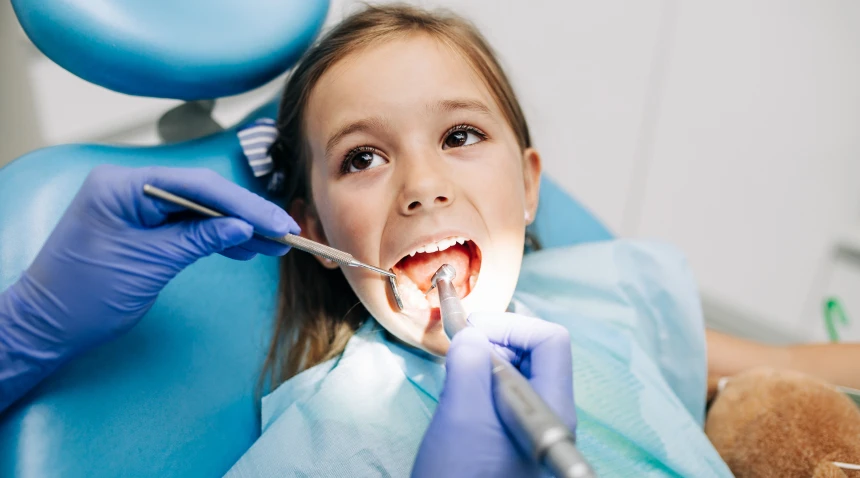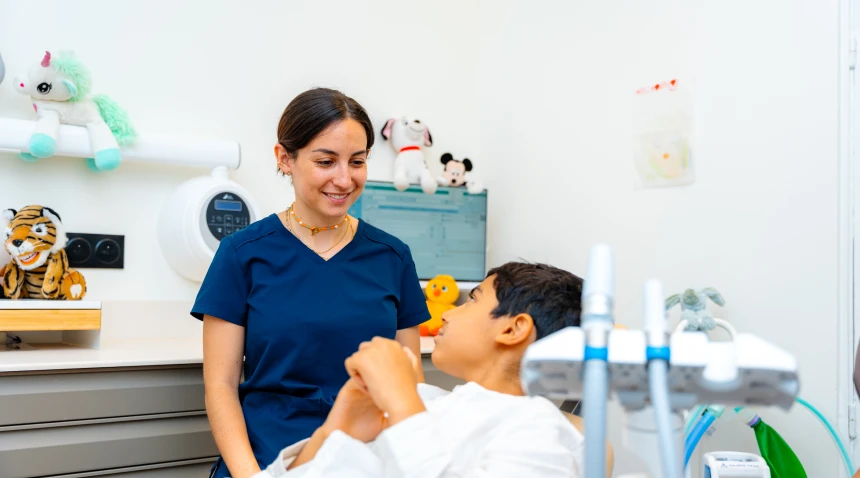From the moment the first teeth appear, children can develop cavities. Contrary to popular belief, baby teeth are just as important as permanent ones. They play an essential role in jaw development, chewing, speech, and the proper alignment of adult teeth. A cavity on a primary tooth can cause pain, infection, and even significant discomfort in a child’s daily life.

Tooth decay results from an imbalance between the bacteria present in the mouth, dietary sugars, and time. When a child frequently consumes sugary foods, the bacteria transform these sugars into acids that gradually attack the enamel. Without treatment, the lesion deepens and quickly reaches the dentin, then the pulp. In young children, this process can progress very rapidly, making it essential to detect cavities early and treat them promptly.
Why treat a decayed baby tooth?
Some people mistakenly believe that a decayed baby tooth does not need treatment because it will eventually fall out. In reality, it is always necessary to intervene. An untreated primary tooth can cause severe pain, eating difficulties, sleep disturbances, and in some cases, infections that may spread to the face.
Furthermore, losing a baby tooth too early can disrupt the eruption of permanent teeth. The neighboring tooth may shift and block the space intended for the adult tooth. As a result, the child may later develop misalignment issues that require orthodontic treatment.
Treating baby teeth is therefore essential to preserve oral balance and ensure the harmonious development of the mouth.
Warning signs for parents
In children, tooth decay does not always cause pain at first. However, certain signs should prompt a dental visit:
- A white, brown, or black spot on a tooth
- Persistent bad breath
- Complaints during meals (chewing discomfort, localized pain)
- Changes in behavior (fatigue, irritability)
- Redness or swelling around a tooth
Even without symptoms, regular check-ups help detect the early stages of decay and allow timely intervention. From the age of 2, it is recommended to take your child to the dentist once a year.
Stages of cavity treatment in children
When a cavity is detected, the dentist evaluates the condition of the tooth to determine the most appropriate treatment. The procedure takes place in several stages, using a gentle and progressive approach adapted to the child’s age and level of cooperation. The goal is not only to treat the lesion but also to preserve the natural tooth as much as possible. At the same time, the dentist uses these sessions to raise awareness in both the child and the parents about the importance of oral hygiene and prevention.

The stages of treatment include:
- Examination of the tooth
The dentist examines the affected tooth and, if necessary, takes a small X-ray. This helps assess the depth of the cavity and plan the most suitable treatment. - Building trust
Before beginning, the dentist takes the time to explain each step to the child. This helps foster cooperation and reduce anxiety. - Local anesthesia if needed
If the cavity is deep or the child feels discomfort, local anesthesia may be used to ensure a painless procedure. The needle is very fine, and the injection is quick and gentle. - Cleaning the cavity
The dentist uses small instruments to remove decayed tissue. The goal is to eliminate all bacteria while preserving as much healthy tooth structure as possible. - Filling the tooth
Once the cavity has been cleaned, it is filled with a suitable material, often a composite resin. This material matches the color of the tooth, providing a discreet and aesthetic result. - Verification and adjustment
The dentist checks that the restoration does not interfere with chewing and makes any necessary adjustments so the child can close their mouth comfortably.
Thanks to this step-by-step approach, the child feels reassured. Many children become very cooperative, especially when gently guided by both the dental professional and their parents.
Early childhood cavities: the situation in very young children
In children under the age of six, this condition is sometimes referred to as early childhood caries or baby bottle tooth decay. This type of lesion often affects the upper front teeth and progresses very quickly. It usually occurs in children who regularly consume sweetened drinks (juice, sweetened milk) from a bottle or training cup, especially at night.

The treatment depends on the severity of the lesions. If the cavity is superficial, a simple sealant or a quick filling may be sufficient. However, if several teeth are affected and the dentin is exposed, treatment under local anesthesia may be necessary to ensure comfort. In more advanced cases, specialized care may be recommended to preserve the tooth or prevent complications. In all cases, prevention remains the best approach to avoid this type of situation.
Preventing cavities in children
Prevention begins at a very young age, sometimes even before the first teeth appear. Parents play a central role in establishing good oral hygiene habits.
Here are a few key tips:
- Clean your baby’s gums with a damp cloth from the first months of life.
- Brush teeth morning and evening as soon as the first tooth appears.
- Use a fluoride toothpaste appropriate for the child’s age.
- Avoid frequent snacking and sugary drinks between meals.
- Offer water as the main beverage.
- Schedule a dental check-up once a year starting at age two.

Dental professionals can also apply a fluoride varnish to strengthen the enamel or seal the grooves of molars when needed. These simple, painless procedures help significantly reduce the risk of cavities.
FAQ – Cavity treatment
- Is cavity treatment painful for children?
No, in most cases the procedure is painless. For superficial cavities, the child feels nothing. When the decay is deeper or the patient is more sensitive, local anesthesia ensures a comfortable experience. The dentist always adapts their approach to reassure and support the child. - Can a severely damaged baby tooth be treated?
Yes, even a severely affected tooth can be treated. If the pulp is involved, a conservative treatment such as a pulpotomy or pulpectomy may be performed. These procedures help preserve the tooth until it naturally falls out and prevent complications for the permanent teeth. - At what age should dental visits begin?
A first dental visit is recommended around the age of two. This early consultation helps the child become familiar with the dental environment and establishes the foundation for good preventive care. Afterward, annual check-ups help monitor tooth eruption and detect early signs of decay. - Are cavity treatments reimbursed for children?
Yes, cavity treatments for children are covered by French Social Security. In addition, the M’T dents preventive dental check-ups are offered free of charge starting at age 3, at regular intervals. A complementary health insurance (mutuelle) may also cover additional costs, particularly for specific treatments.
Where to treat a child’s cavity in Paris 16?
The Cabinet dentaire Mirabeau, located in Paris 16, welcomes children for cavity treatment in a reassuring environment adapted to their age. Follow-up care is attentive, and each procedure is carried out with respect for the child’s pace and comfort. To make planning easier, appointments can be booked online in just a few clicks.
You may also like: MEOPA